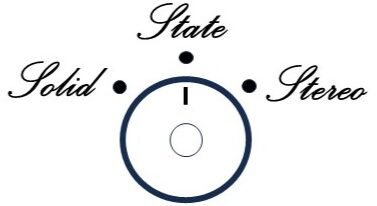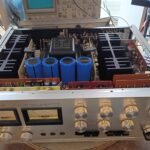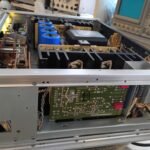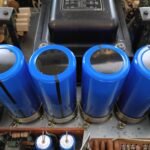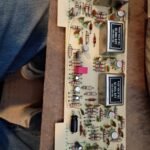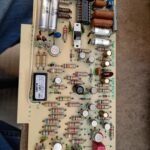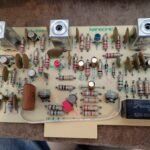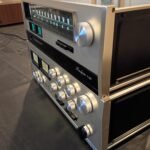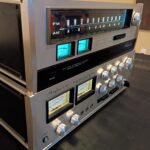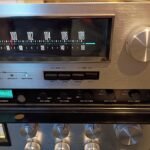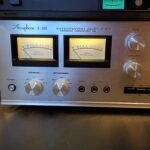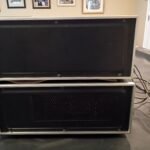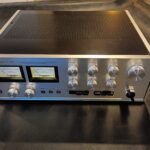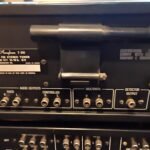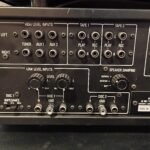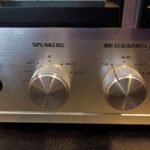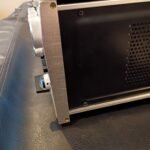Accuphase E202+T100
$1500

Examples of interior restoration results (click on photos to expand)
Restoration notes
Beyond the list of standard restoration steps detailed on the main page, here are some added notes for this unit :
The original owner contacted me as he was down-sizing and wanted his Accuphase e202 and t100 to go to a good home. I have gotten a few calls like this, and I am always honored that folks trust me to adopt their prized audio gear. These were both in very good cosmetic condition while the e202 had developed an internal issue and would not come out of protect mode on power-up.
The e202 and t100 are both from the early 70s, and are very highly regarded units with amazing build quality and performance.
Accuphase e202
Premium features
left and right phono input level adjusters for disc (phono) 2 for matching to other amplified input levels
impedance settings for disc (phono) 1
speaker damping setting (20 “normal”, 5 and 1 “softer” to “sooth” older speakers)
disc (phono) mode RIAA “low enhance” and subsonic filters
I confirmed the power-up issue and found that 1 of the 8 output transistors was bad. Note that to achieve the rated 100 watts per channel, Accuphase used 2 TO3 transistors in parallel in each of the normal 4 output transistor locations (which gets us to 8 total). All 8 were replaced with matched modern equivalents along with new mica and thermal grease. I also touched up several cold solder joints on the power supply/protection board. Unit now powers up correctly. The protection relay is not standard and is hard to access. The original works fine, so I decided to leave it alone. Amplifier DC offset and idle currents were checked and set to spec.
While the Accuphase engineers did a great job designing this integrated amplifier, I do have one criticism. The engineers failed to use any “keying” on the PCB edge connectors and the boards are designed symmetrically which enables a careless tech to plug them in backwards. There are stamped “component side” warnings in the chassis to reduce this likelihood, but IMHO, keying should always be used. Several of the cable connectors could also be reversed (again due to lack of keying). Final head-scratcher is designing the 2 plug-in tone amp modules with identical board profiles and connector placements so you can accidentally swap them when re-assembling (why go out of your to enable this?)
Initial functional testing showed normal issues due to noisy controls (easily addressed). Other issues required unseating all boards and cable connectors so the contacts could be cleaned.
This is a direct-coupled amplifier and there are 4 large 10,000uF 63V caps (2 in parallel for the positive and negative amplifier supplies for a total of 20,000uF per rail). Given the quality of this amplifier, I decided to install four 12,000uF 100V caps made by the highly rated German firm F&T. These tested at 10,500uF each, so a modest/safe “up capping”. Please contrast this to posted youtube videos where tiny/cheap main caps (poor ESR, etc) are swapped into this high end amplifier (ugh).
Most of the other electrolytic caps were axial (vs radials that were more typical in 70s gear). For body sizes over 10mm, I replaced these with axials (high-end RIFA caps for all audio path axials). I replaced the smaller body axials (10mm or less) with radials as the availability of low leakage caps, etc is much better with radials. Purists may cry “foul” at this point, but this was the right call, IMHO.
I do notice a soft scratchiness when adjusting the volume knob near the ~75% point (3 o’clock position) with no input. I did what I could with faber lube and consider this to be acceptable as the amp hits the rated power output (100 watts per channel) around the 70% point. Finally, the amplified music level is so high over 60% that this soft scratch sound would not be audible.
There is also a “pop” when turning the input selector to either of the phono inputs when the volume is turned up. The selector switch has been thoroughly flushed/cleaned and each position sounds fine. This momentary issue is only when changing the selected input. Having the volume low when switching to/from phono avoids the “pop”.
The e202 cosmetics are very good. One of the speaker terminal screws was missing. These are “non-captive” and will simply fall out if reversed too far. After some trial/error, I determined that these were rather unusual metric M3.5 x 6mm screws, so all are again present. The metal cabinet to has scuff marks (likely from the tuner being set directly on top and shifted around). The right side has some scratches on the chrome side piece attached to the faceplate. The faceplate has some very light scratches (not easily seen) and the knobs have a few dings (volume being the worst example). Please check the blemish photos, etc.
It certainly sounds awesome and the power meters are entertaining.
Accuphase t100
Premium features
independent output level controls for AM and FM
AM “local” and “distant” settings
2 levels of FM muting
FM multipath meter
2 dial lamp brightness levels
extensive interior shielding
The intended tuner for the e202 was the t101. The t100 was released before the e202 to be used with the c200 pre-amp and p300 power amp. It has the same overall width as these, while the e202 and t101 are 10mm wider (not sure why Accuphase did that…) The small difference cabinet width can be seen in the photos. Given all this, it is still very common to see the t100 paired with the e202 as the t100 is seen as a better tuner than the t101 (certainly higher build quality).
Please see the photos of the internal shielding used by Accuphase in the t100. These help reduce background noise, keep dust/dirt away from the electronics and are plain gorgeous, IMHO.
The t100 powered up fine and was highly functional. The main issue is the unfortunate “freezing” of the small black controls on the right behind the flip-down black panel along the bottom. The original grease applied seems to gum up over time and getting these controls freed up is a challenge. The rotary switch used for turning on/off the MPX filter did not survive and was replaced with a new switch. The “stop” on the FM muting switch is not working. No issue if the user only moves the switch within the 3 labeled position/settings (FM muting: off, level 1, level 2).
The recap went smoothly (same policy on axials as the e202) and the alignment needed little tweaking. The sound is rather “lively” and I think that may be due to the quality of the left/right channel audio amplifier boards.
Cosmetics are again very good with minor dings that are not immediately apparent. Quite good given this is 50+ years old.
Bench measurements
Accuphase specced the e202 amplifier at 100 watts per channel under standard test conditions (both channels driving 8 ohms from 20 to 20,000 Hz) with a max harmonic distortion of 0.1%
My results under the same conditions was 123 watts per channel at the minimum distortion I feel my test gear can measure accurately (0.5%). That said, I am confident this amplifier is easily exceeding the original specs based on scope observations over 100 watts per channel (absolutely clean, no sign of clipping).
Some reference links
e202
hifiengine : https://www.hifiengine.com/manual_library/accuphase/e-202.shtml
review : https://www.youtube.com/watch?v=hWg03Ngax-k
t100
hifiengine : https://www.hifiengine.com/manual_library/accuphase/t-100.shtml
review : https://www.audioasylum.com/reviews/Tuner/Accuphase/T-100/general/65674.html
